If you’re walking around with an ingrown toenail, there’s a good chance it’s uncomfortable and painful. But did you know that there are a few simple steps you can take at home to help ease the pain and speed up the healing process?
The first step is to trim your nails regularly. This will help prevent the nail from growing into your skin. The second step is to use dental floss on the ingrown part of your nail to help relieve pressure and pain.
Read on to learn more about How To Use Dental Floss On Ingrown Toenail, Effective and Gentle Cleaning with Dental Floss

How To Use Dental Floss On Ingrown Toenail
While this effectively allows the skin around the toenail to heal, it does not address the underlying toenail curvature problem. Therefore, it’s considered a temporary ingrown toenail pain relieving solution. This is one of the least aggressive methods to get rid of ingrown toenail pain and involves using an adhesive elastic tape. The tape is usually as thick as the height of the nail, with one end attached to the lateral nail fold beside the offending nail edge. For best results, this end should be tucked slightly into the nail fold to be able to pull the skin away more easily. The tape is then pulled taut, and should be long enough to go around the toe in an oblique manner. The other end of the tape should be able to reach the opposite nail fold but is placed obliquely so as not to cover the toenail and constrict the toe. For taping to be effective, it has to be done correctly and consistently. You may ask your doctor to teach you how to use the correct technique in applying the tape. Experts recommend that re-taping is done once to twice a week, especially if the tape has lost its stickiness.
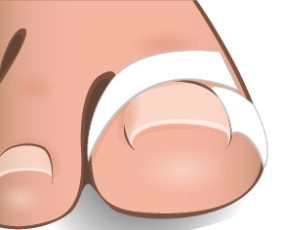
Tape being used to pull the skin away from the toenail
Orthonyxia or toenail bracing
By far the most effective method to get rid of ingrown toenails. It is the only method available that corrects the curve of the nail, the root cause of an ingrown toenail. Orthonyxia involves the use of a small corrective toenail brace, usually metal or composite, placed over the surface of the nail. If a metal brace is used, the edges are hooked on each side of the nail, then are tightened by pulling them together. This pressure aims to pull or flatten a nail that is too curved and prevent its edges from growing inward into the skin. Plastic nail braces are also available, where they are bonded to the nail surface. This helps the nail to gently grow in a less curved manner. The nail brace, when kept on for a number of weeks to a few months, can permanently correct unhealthy toenail curvature.
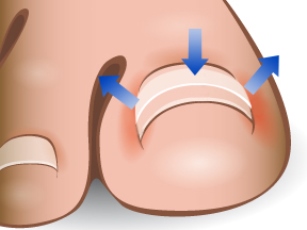
Corrective toenail brace
Not recommended – Temporary, ineffective and unhealthy ways to get rid of an ingrown toenail
Trimming off the ingrown side of the toenail
This technique is usually done by trying to dig out the ingrown edge then trimming away the ingrown side. While this may temporarily get rid of pain, it is not highly recommended since doing this merely cuts off the sharp edge but does not prevent the nail from growing in the same direction again. Also, digging out the ingrown side, especially if the skin has already been punctured, can increase the risk for infection and complications.
Cotton or dental floss under the corner of the toenail
This technique involves packing a small piece of cotton or a string of dental floss under the edge of the ingrown toenail. This forces the nail up and allows the edge of the nail to be lifted out from the skin. The cotton or floss is encouraged to be changed daily, and when replaced each time, more cotton or floss may be added to attempt to raise the nail edge higher. This is performed daily until the edge of the nail is visible. This method is discouraged because permanent reshaping of the nail cannot be achieved however it may provide some temporary relief of ingrown toenail pain. It cannot be considered a long term solution.
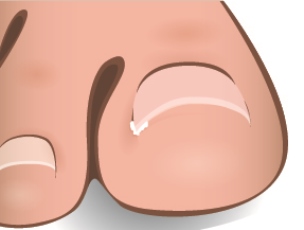
A piece of cotton or dental floss placed under the corner of the toenail
Cutting a “V” in the end of the toenail
V-cutting involves trimming the end of the nail such that a V-shape is formed at the free edge. This is said to encourage the nail to grow toward the center and prevent future instances of being ingrown. This is totally untrue since all nails grow from the base upward, thus, a V-shaped trim won’t really affect the direction your nail grows.
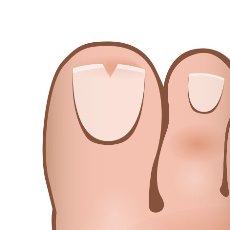
Cutting a V shape into the free end of the toenail
When not to treat at home
Chronic infection
If you observe any signs of infection near the ingrown toenail, such as a wound with oozing and drainage, swelling, pain and redness, which do not resolve even if certain home treatments have been done, it may be time to visit your doctor. Your ingrown toenail may already have progressed to a chronic infection and may have to be treated medically. Your doctor may also need to prescribe antibiotics to treat the infection.
Diabetes and poor circulation
If you have diabetes or any other condition that is associated with poor circulation, it is highly discouraged that you perform any home treatments on your ingrown toenail. Poor circulation in your legs can lessen sensations, thus, you may not have felt any pain or other bothersome sensations in your toe. This also makes you more prone to complications and progression of the ingrown nail.
Dental floss toothpick
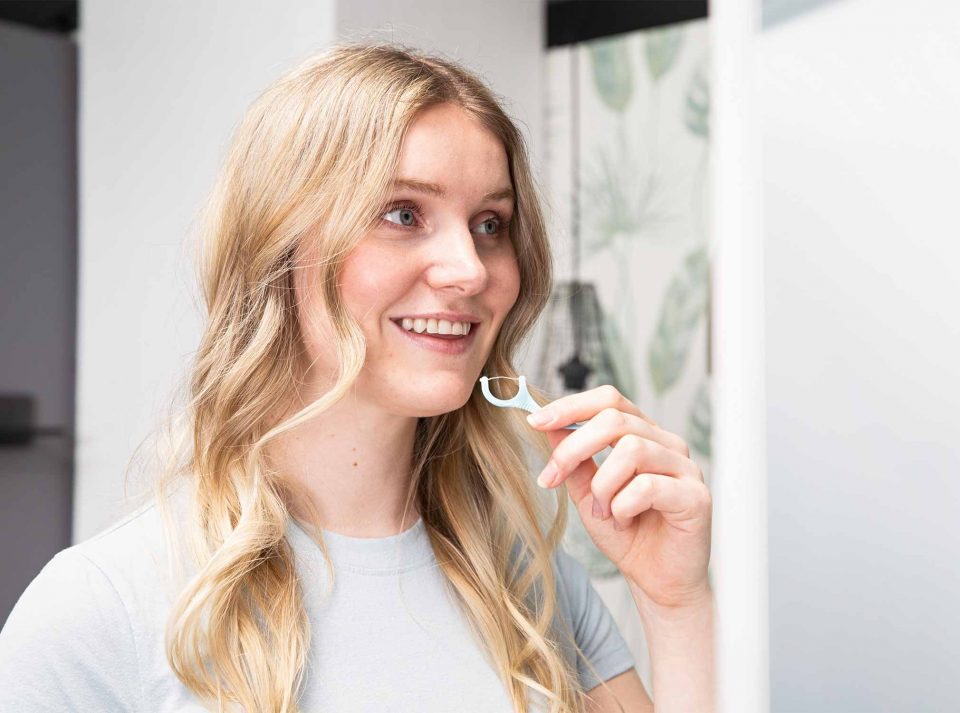
Is using toothpicks or dental floss a part of your daily routine? If not, make that change today! Cleaning between your teeth is a great way to get rid of food that may have gotten stuck throughout the day. Sometimes we do not even notice these little leftovers, so try to do this every day regardless of whether you feel that little seed from your sandwich between your teeth or not.
Toothpicks or Dental Floss?
Toothpicks and dental floss come in different shapes and sizes so that you can choose the one that fits you and your teeth. Although you can pick one or the other, you can also use both depending on the situation. The most important thing is making an effort every day with brushing and cleaning between your teeth. This will help ensure good dental hygiene with healthy teeth and gums.
Effective and Gentle Cleaning with Dental Floss
Using dental floss once a day is often enough for most people, but feel free to use it more if needed. A good tip to help you remember to floss is to floss every night before brushing your teeth. This will help get rid of any leftover food between your teeth. Which then makes cleaning them with a toothbrush afterwards easier.
There are many different types of dental floss, for example some are designed for especially small spaces, such as Easy Slide Floss. Others expand to ensure more effective cleaning for slightly larger spaces, such as Expand Floss.
If you struggle to reach all of your teeth using regular floss a flosser tool, such as the Easy Clean Flosser, may be right for you. They come with a long handle making it easy to move around in your mouth. Also, this convenient handle makes it easy to store alongside your toothbrush. This may help act as a visual reminder to floss.
When using dental floss in any shape or size remember to be gentle. To maintain clean and healthy teeth gently move the floss up and down between your teeth. Try to avoid any sawing motions from side to side.
A great alternative: Toothpicks
If you are already using dental floss, great, then you do not have to use toothpicks as well. Yet, they may still come in handy especially on the go. They are easy to carry around and can help you remove that stubborn piece of food that got stuck during dinner.
As with dental floss, there are several types of toothpicks to choose from. Our Dental Sticks come in a nice dispenser, making it ready for display on your dinner table. With natural flavour and no additives, it is suitable for all occasions. Another option is Clinic Thin Toothpicks, which contains fluoride and mint. These are recommended for those with narrow to normal spaces between their teeth.
Again, remember to be gentle especially if you have sensitive or receding gums. A good start is to use dental floss daily and use toothpicks as a helpful supplement when needed.
Dental floss thread
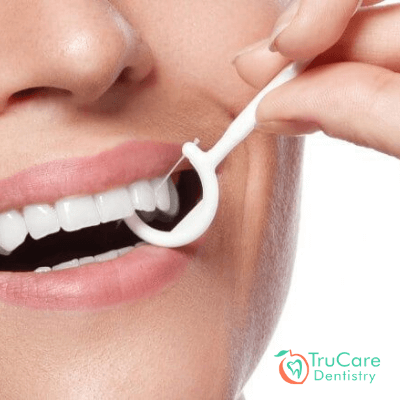
Flossing helps prevent gum disease as removing plaque accumulated around the teeth can ensure the mouth remains clean and healthy. Flossing regularly with the best suitable type of floss can help avoid unplanned visits to the dental office. Here’re some of the most recommended types of flosses and their uses.
Simple floss (Dental floss)
Simple dental floss is a thread consisting of thin filaments. It helps in cleaning spaces between the teeth before tooth brushing. These threads can reach and clean teeth from every angle, ensuring the gumline areas remain spotless. You can buy a pack at grocery stores or pharmacies. However, this floss is not recommended for patients who have dental retainers, bridges, or braces.
Floss threaders
A floss threader is a piece of plastic that’s flexible and rigid. It assists the dental floss to pass around orthodontic wires, dental bridges, and retainers. Floss threader appears like a needle and can easily pass from the small space between the teeth.
Patients who have orthodontic appliances fitted in the mouth as a part of treatment do not have to neglect teeth. Floss threaders help them in cleaning all the teeth properly. Floss threader works fine with any floss thread, and you can buy the same from a pharmacy or a shopping mall that has a dedicated section for dental care products. Reusable floss threaders are most recommended, as they can be reused after merely rinsing with warm water after use.
What’s super floss?
The areas around bridges, braces, and dental wires can prove to be a heaven for plaque and harmful bacteria. Thus, these dental fixtures need proper attention while cleaning. And this is where super floss comes into the picture. These flosses have three components that work together—a regular floss thread, spongy floss, and a dental floss threader that has a stiffened-end.
The first part is stiffened-end dental floss. The spongy part (middle segment) of the floss consists of cotton or nylon threads coated with wax. The end part is a simple wax-coated piece of thread.
Super floss allows patients to clean the areas around dental fixtures, remove plaque accumulated under the gumline, and clean dental braces, bridges. Several brands offer flosses with multiple threads for cleaning braces. However, Oral B super floss is the most preferred option. You can purchase it in a box of single floss or a packet of 50.
Floss picks
Floss picks consist of a small handle with two end posts that hold a short string of floss. Also referred to as floss sticks, they can be used as an alternative to a wooden toothpick.
A floss pick is perfect for getting rid of food particles that accumulate between the teeth and along the gum line. It cannot clean areas under braces, retainers, and bridges. Dentists recommend the same for patients who have issues with their hands, fingers and cannot use a wooden toothpick. Some floss picks have threads that can work as tongue scraper as well. You can also opt for floss picks with handles that have no-slip grips.
Oral care products manufacturers also offer battery-powered floss picks in selected markets. These units are designed to clean the teeth, gums, and vibrate to massage these areas.
All-natural products
Patients can also opt for locally manufactured all-natural flosses that are either made from biodegradable silk or other natural materials. There are products with threads infused in tea tree oil or other natural antimicrobial oils.
Water picks and flossers
Advanced water flossers can remove the plaque between teeth within seconds. These devices use bursts of water and air for hasslefree cleaning. The option is best for patients who are uncomfortable with string floss. Users can fill water or mouthwash in the device, aim the nozzle on the affected teeth, and blast the debris away with just a few seconds. Your dentist can recommend the best water flosser as per your dental structure.
There’s no one-floss-for-all
One flossing product may not be suitable for all family members. Preferences of members change over time as per the individual’s dental health condition. Children initially need child-sized flossers and can opt for an electric flosser at a later stage. Similarly, persons with dental fixtures cannot do with simple floss and require floss threaders or super floss.
Unfortunately, just around 4 out of 10 Americans spend time in flossing daily. Initially, it may seem time-consuming, but it only takes a few minutes once you get used to the same. Individuals who floss just once should consider doing it before brushing every day so that the plaque and bacteria loosened after flossing are removed while brushing.
If you need a reputed dentist who can recommend the best type of floss for you or your child, you should fix an appointment at TruCare dental clinic in Roswell (GA).
FAQs Related to Flossing
Here are some of the frequently asked questions about flossing, have a look:
1.How often should you use super floss?
It is advisable to floss every day. While cleaning the teeth, dental fixtures need proper attention. Ignorance can lead to the buildup of plaque and harmful bacteria. Therefore, cleaning with Super Floss helps manage oral hygiene while protecting the teeth from caries/decay and periodontal problems on the abutments.
2. Is it OK to not floss with braces?
No, flossing is essential if you are wearing braces. Braces can easily accumulate food particles, liquids, or sugars when you eat or drink something. If not cleaned properly, it may lead to serious teeth and gum problems. Therefore, to ensure the good health of your teeth and gums, you must not ignore brushing, flossing, and regular dental checkups.
3. How many times can you use a floss stick?
Flossing is done to remove food particles, plaque, and bacteria from between the teeth. Reusing the same floss stick may reintroduce the old bacteria and even some varieties of bacteria. Therefore, it is better not to use the same floss stick again.
4. Is a water flosser good for braces?
Yes, using a water flosser for braces is safe. It is a perfect tool to reach in those hard-to-reach corners
and gaps. Thus, help to keep teeth healthy and clean.
5. Can I use a normal thread for flossing?
Normal threads have a rough texture that may harm the gums if flossing is not done carefully. Besides, normal threads can break easily and get stuck in between the teeth. Instead, use dental floss that is specifically made for flossing purposes and is gum friendly. Dental floss can remove debris and plaque in-between the teeth easily without causing any harm.